Introduction
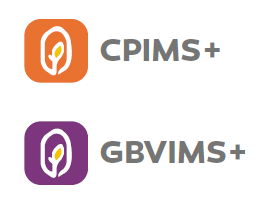
The Information Management and Innovation to Protect Children in
Emergencies project has developed a software application that will
help partners securely collect, store, manage, and share data for
protection-related incident monitoring and case management. The new
platform is called Primero (Protection-related Information
Management). Primero supports multiple modules, including the “next
generation” of the field-tested, inter-agency CPIMS and GBVIMS systems,
which are currently in use in 20+ countries. These new iterations,
called the CPIMS+ and GBVIMS+, can operate separately or be deployed
as integrated modules on the Primero platform. The inter-agency
Steering Committees that govern the use of each of these modules will
continue to support the new system.
 Primero is flexible and adaptable to accommodate a broad range of
protection concerns including GBV, unaccompanied and separated
children, and monitoring grave violations of children’s rights in situations
of armed conflict. To meet operational challenges, the application was
designed to function both on- and off-line, with limited or no connectivity,
and in multiple deployment configurations. A strong emphasis has been
placed on security and confidentiality, with intuitive workflows designed to
Primero is flexible and adaptable to accommodate a broad range of
protection concerns including GBV, unaccompanied and separated
children, and monitoring grave violations of children’s rights in situations
of armed conflict. To meet operational challenges, the application was
designed to function both on- and off-line, with limited or no connectivity,
and in multiple deployment configurations. A strong emphasis has been
placed on security and confidentiality, with intuitive workflows designed to
simplify processes while promoting good practice. Role-based access and
granular security ensures that only those who need to see data will have
access to it. All system transactions are time stamped, password protected
and encrypted. Primero has a user-friendly interface and intuitive tools,
facilitating the work of field personnel while decreasing security risks and
duplication. The application can leverage mobile data gathering tools such
as RapidFTR on smart phones and tablets. In order to optimize results,
Primero was designed to be able to exchange data internally between
modules, as well as externally with other IM systems. In addition to imports
and exports, Primero has a highly secure application program interface
(JSON API).
Primero functions as a distributed database, meaning that
implementing partners can retain ownership of data while contributing
and sharing information on shared programmes. In child protection
interventions, referrals and case transfers are critical to effective
service provision. Sharing sensitive information is a part of good
programming. Data exchanges between organizations should be governed
by endorsed information sharing protocols adapted to local contexts.
Primero design is based on the “need to know” principle; it does not
impose data sharing, but facilitates the process when consent is
provided, and when it is deemed appropriate and safe by partners.
Good information management practice emphasizes the importance of making data actionable. Primero has built-in customizable reports that can facilitate periodic reporting processes, and be used to analyze data for programmatic insights. A document and photo repository allows end users to organize relevant resources in one convenient place.
A note for end users. Although there are a standard set of forms configured in the CPIMS+ based on the CPWG standard forms that we recommend using, your System Administrator may have configured these forms specific to your location
and needs. For any questions about the forms and information you have or need,
please reach out to this person
Logging In
When logging into Primero, you’ll see Username and Password boxes. Click in the Username box and type in your unique user name provided to you by your System Administrator. Then enter your password in the field below and click on 'LOG IN'.
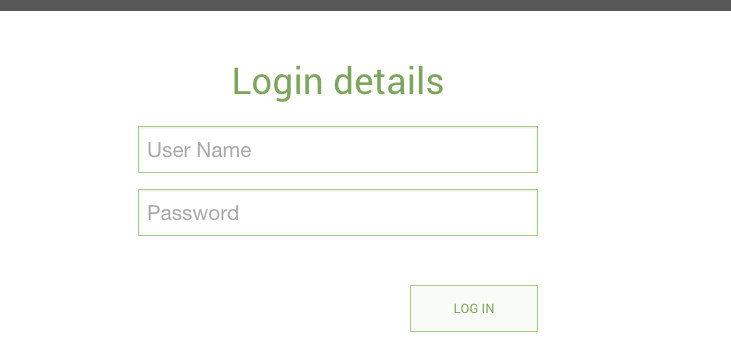
Navigating Primero
Header Navigation Bar
The header navigation is the dark bar across the top of the screen in
which you navigate to your home page (or dashboard), Cases, Tracing
Requests, Reports, and bulk export downloads. It also has a quick
search field that can help you find a specific case quickly. Your current
page will be highlighted. See below:

Dashboard
The Dashboard, or Home Page, is where you can quickly find information for your cases. Depending on the work you do in your organization, it contains a number of different types of information, which can include caseload summaries, recently flagged cases, cases for which approval has been requested or cases that are pending approval, referred cases, etc. The case worker dashboard will be different, from the managers and from the administrator.
Case Dashboards
If your user has access to cases through either the CP or GBV module,
you will see one--and only one--of the following three case dashboards.
Cases Dashboard
The first example below is the basic Cases Dashboard. If you have any
access to cases, but you are not a manager or an administrator, you will
see this dashboard. The dashboard is divided into two main sections: one
for cases, one for responses. The first section (first picture below)
begins with a few key metrics: total cases, total new cases, transfers
awaiting acceptance, new incidents, services implemented, total referrals,
new referrals, pending transfers, and rejected transfers. (In these
metrics, “new” means anything which has not been edited since its
creation.) Below these key metrics lie two columns. The first shows
the number of total and new cases, subdivided by assessment level. The
second column shows all the number of pending, rejected, and new approvals,
subdivided by the type of approval.
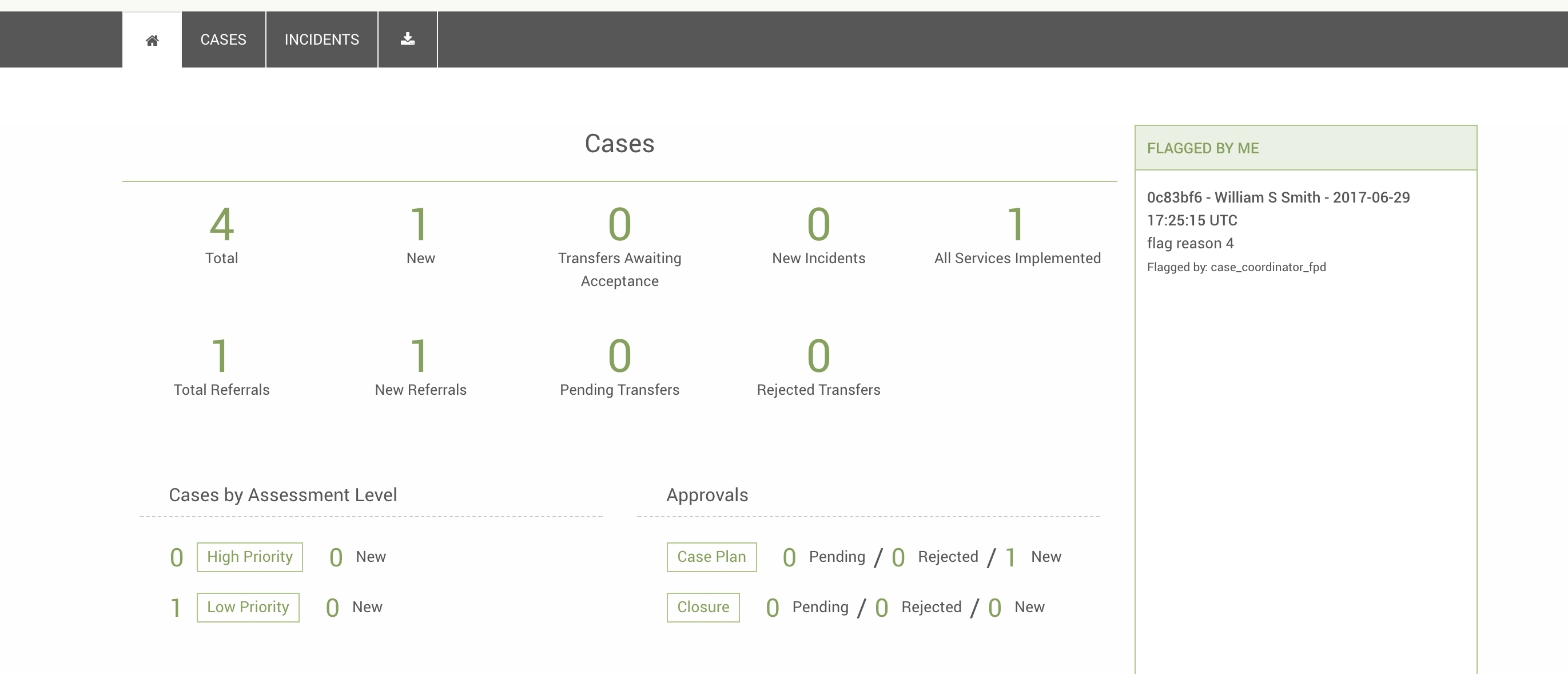
The second portion of the cases dashboard outlines all responses for the user's cases, with a column for each response type. Within each column, responses are broken down by priority level, at which point numbers are given for total responses as well as those nearing or past their deadlines (as determined by the timeframe specified for a given response). Clicking any of these numbers will take the user to a list of the cases in question. This allows users to easily manage the most urgent tasks for their cases, in order of priority.

Manager Dashboard
The Manager Dashboard, meanwhile, appears if you have managerial tasks in your organization. This dashboard does basically the same thing that the Cases Dashboard does, but also sees the cases of the team you manage. The first section tells the number of total and new cases you have. The next section lists the total and new cases that each team member has. Below that is a list of the total and new referrals for each of your managed users. The final section breaks down the number of cases you have by assessment level. As mentioned before, if you see the Manager Dashboard, you will not see the standard Cases Dashboard. A single user can only have one of the case dashboards display on their Dashboard Page.

Once again, flagged cases will be on the right hand side of the screen
if you have the Manager Dashboard. However, this time, there will be
only one list of flagged cases, and the cases there will all be flagged
by you. This is because managers often do not have their own cases and
will thus only be concerned with cases which they themselves have
flagged, and which belong to one of their team members.
Alternatively, the manager dashboard can have also have a different appearance based on the possible actions in the system. The first section tells the number of total and new cases you have, as well as the number of cases that have been transferred to you and are waiting for approval or rejection. The next section lists the total and new cases that each of your managed users has. The next section shows you cases with BIA, Care Plan, or Closure forms you have approved or are waiting for your approval. Below that is a list of the total and new referrals for each of your managed.
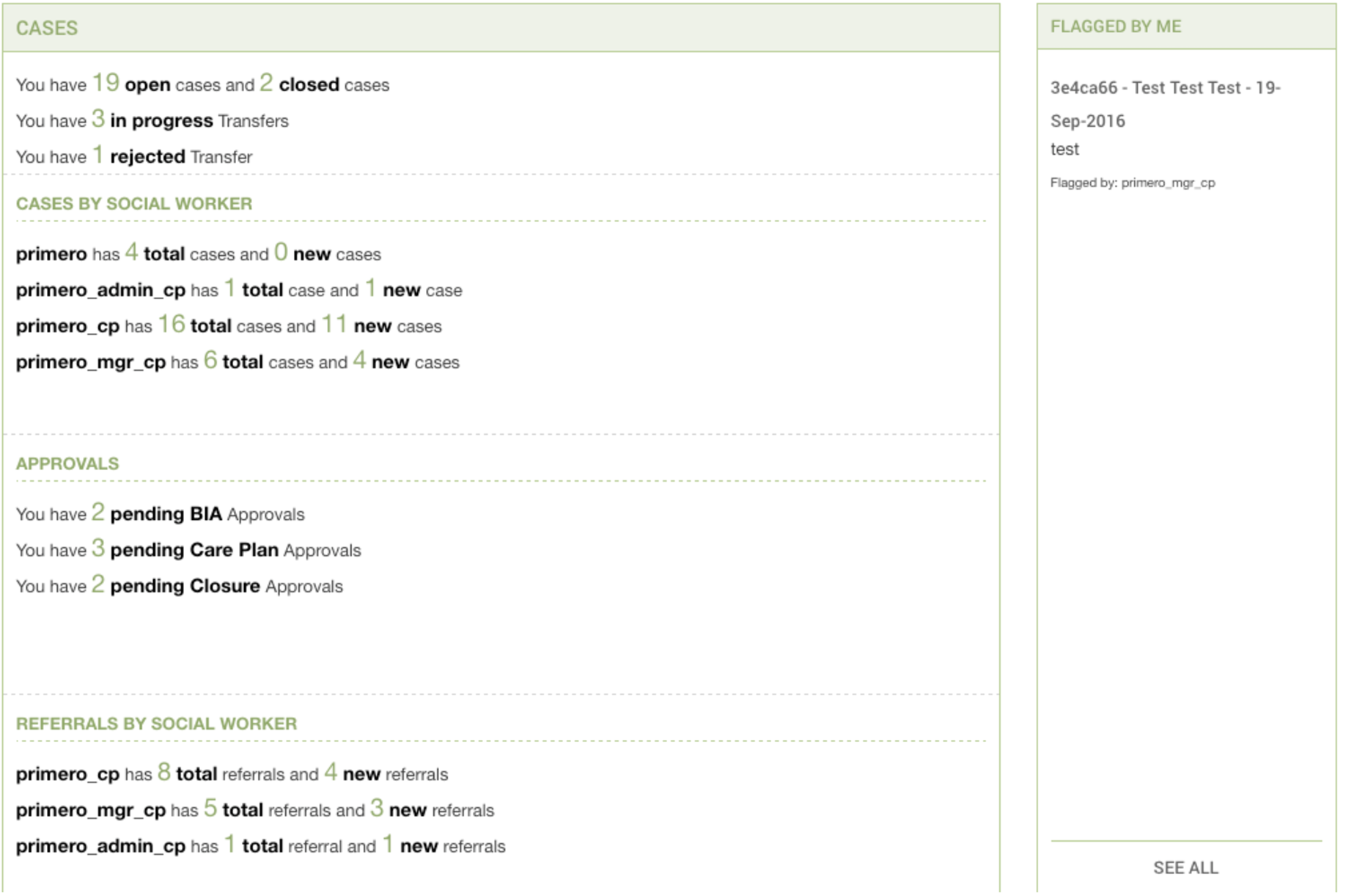
Admin Dashboard
Finally, you will see the Admin Dashboard upon login if your user’s role
has access to all records in the system (thus giving you an
administrator’s functionality). On this dashboard, you will see is a
table of cases by district, with each row broken down into total open
cases, cases created last week, cases created this week, cases closed
last week, and cases closed this week. (Here, a week is measured from
midnight Monday morning to 11:59 Sunday night. This means that for a
case to have been created this week, it must have been created during or
since the immediately preceding Monday morning.) As stated previously,
if you see the Admin Dashboard, you will not see the Cases Dashboard or
the Manager Dashboard, since one user can only have one of the case
dashboards display on their Dashboard Page.
Flags are, once again, on the right. Like the Manager Dashboard, and for
similar reasons, the Admin Dashboard only lists those cases which you
have flagged.
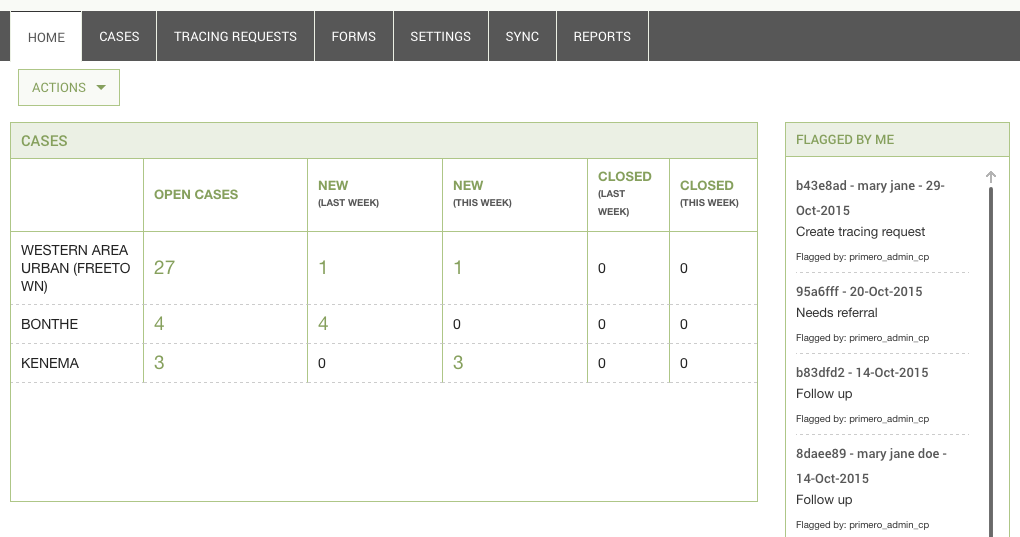
Flagged Case Lists
If you see any of the case dashboards, the right of your screen will
show one or two lists of flagged cases. These lists will keep you
reminded of pending flags. The first list, shown above, consists of
the cases which you have flagged most recently. The second list, shown
below, is a list of your cases which someone else has flagged, and only
displays for the Casesand Admin Dashboards. (Since managers often do not
even have the ability to make cases, it makes no sense for them to have a
list of flagged cases which they own.)

GBV Incident Dashboard
The GBV Incident Dashboard will appear below whichever case dashboard
you have if your user’s role has access to incidents through the GBV
module. The table in this dashboard lists out each incident, with
columns for “Incident #ID,” “Date of Interview,” “Date of Incident,”
and “Violence Type.” Each incident’s id will link to the incident’s
page, and each incident will feature an icon indicating the number of
flags it has, provided it has at least one. To the right of the GBV
Incident Dashboard will be a list of incidents flagged by the user.
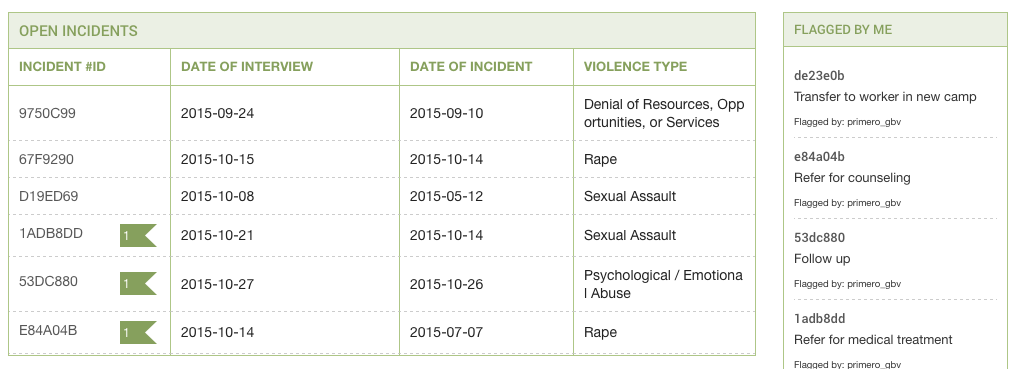
List View
When selecting the record type or page you want to visit via the header
navigation, you can see all cases or tracing requests that belong to you
when you click on CASES. Once there, you see a list of the possible
matching records, that you are able to filter and/or sort. See below:
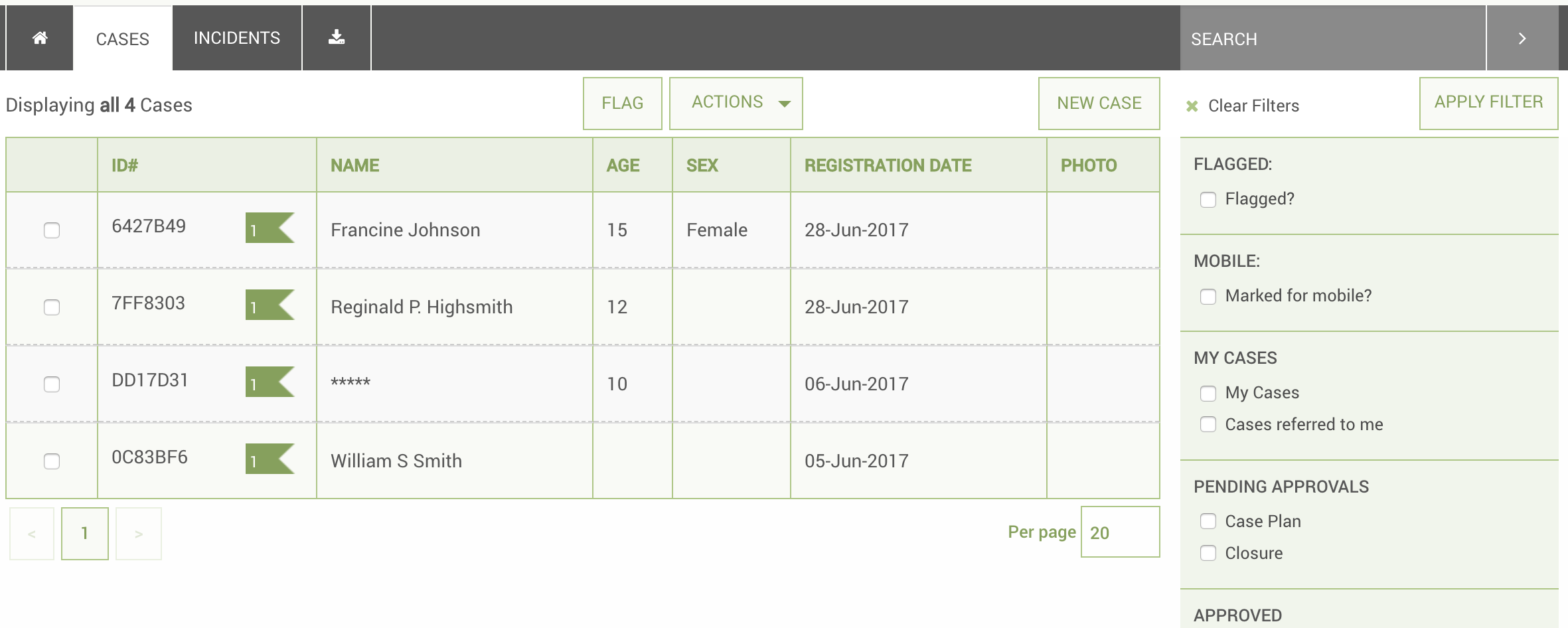
Edit and View a record
When creating a new record, you automatically are brought to the “Edit”
page for that record. You can enter in all the relevant information you
need at this time and save when done.
When selecting an existing record, you are brought to “View” the record.
This means you can view all the data and forms you have permission to,
but cannot edit. You must click the Edit button in the Action Buttons
section of the header to change any information that is currently
represented.
Case Status Bar
On the view and edit pages for a case, the user will see the case status bar, which lets the user know the current case management stage of the record.

When the case is first opened, before any services are added, the status bar will highlight the "New" status. Once a service has been added, however, the case status will correspond with the most recently-added response type. So, for instance, after a case is opened, if a case worker refers the case to a service provider for a service with a response type of "Immediate Response", the case status will also be "Immediate Response." When the case is closed, with manager approval, the case status will become "Closed." Keeping track of the case status helps the case worker keep track of the case's needs. Please note that the case status bar may or may not appear, depending on a given implementation's configuration.
Action Buttons
Our Action Buttons are the buttons just below our Header Navigation,
which allow a user to act on a case or cases. The actions, depending on
your permissions, are:
Flagging
Export
Custom Exports
Import (List View)
Transfer
Refer
Assign
Disable
Save (edit view only)
Cancel (edit view only)
Mark for mobile
Un-mark for mobile
Request Approvals
Approvals
Please note that when using these actions you must work according to the CP SoPs that are in place. Also, the system does not replace the communication that you need to have in a child protection case management program, through case conferences, emails or other to ensure that people are aware of transfers and referrals and to follow up on referred and transferred cases.

This bar, along with the Header Navigation bar and the case status bar, are part of what is called the Anchored Header, meaning, they never leave the screen when scrolling. This allows a user to easily navigate or act on a case or number of cases at any time.
My Account and Contact & Help links
Above the Header Navigation bar, there are small links that bring you to
pages that help you manage your account and contact information, as well
as find out who is your site administrator. Clicking on the Primero icon
from any page will take you back to the dashboard from anywhere.
Filtering
Filtering your Case List or search results is an efficient way to narrow
down to the case or cases that need your immediate attention. You can
filter the list to show not only if a case has other characteristics but
contains specific information within those characteristics as well. For
example, you can filter by males only, but you can also filter by
specific Protection Concern, Current Location, and the case registration
date range.
The Filter panel is on visible on search results page or when you click
CASES tab in the header. See below:

In the image, there is the normal checkbox filter selection, in which
you click using your mouse, but also date range and drop down fields.
For Date Ranges, you can enter these using any of the date field type
actions. You can set the range for one day as well. For the drop down
field, this is clickable with the mouse and you can only select one
value.
Flagging
Flagging a case is a way to alert either yourself or a manager that a case needs additional work or attention. To flag a case:
- Once you have opened the case, click on Flags
- Enter the flag reason and if applicable the Date by which this flag needs to be addressed
- Click flags to complete
Note that only the person who flagged the case can unflag the case. To do so:
- Click on the (+) button next to the flag, under the Unflag Case heading.
- Enter a reason for unflagging the case.
A history of the flags and unflags for the case is stored. To see the history, click on the View History tab, you can view the details of the flags and unflags.

Assign Users
Managers have ability to assign a case to a different user. If you select the Assign option from the Actions dropdown menu, a modal will appear that allows you to select from existing users. Assigning the case will change the record owner to the selected user, that record will no longer be available to the previous case worker.
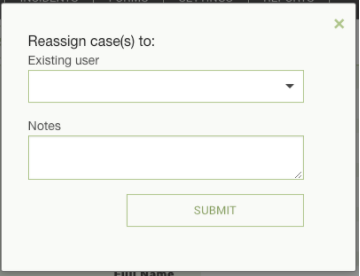
Reopen
Users have the ability to reopen closed cases. Reopen displays in the Action menu on the case view page below Disable; it does not display on the case list view . Clicking Reopen brings up a confirmation dialog saying that clicking ok will change the status of the case to open. When the user clicks OK, the “Case Reopened?” field in the Basic Identity form is checked, the case status is set to Open, and the case’s state is set to Valid. This also creates an entry on the Record Information form.

Approvals
Caseworker
Case worker roles have the ability to request approval for a case plan, BIA, or closure from the manager. This is done by going into the ACTIONS button dropdown, clicking on "Request Approval," and then clicking on the type of approval you would like to request. This will produce a modal to submit the request.
If you request a case plan approval, the below modal will appear. Select a case plan type (the options will correspond with the various response types) and then click "OK."

The modal for requesting closure approval will be similar, except that it wil not have a dropdown for case plan type. Here, simply click "OK" to request approval.
Once the approval request is made, it will show up as pending under the approvals section on the caseworker dashboard. It will also appear on the manager’s dashboard as a pending approval. Once the manager approves or rejects the form for the case, the status will change on both the case worker and manager dashboards.
All approvals for a case will also appear in the Approvals form section on the case edit and view pages. Here, you will see the type of approval (case plan or closure), the approval's status, the date of the approval request, and, if the approval is for a case plan, the type of case plan.

Managers
Managers may have the ability to approve a case's case plan and/or closure, depending on configuration. To check to see if any approvals have been requested for a case, a manager can go to the Approvals form on the case view page (pictured above). As you can see, an entry for an approval in the forms will tell you what type of approval it is (BIA, Case Plan or Closure).
To perform an approval, go into the ACTIONS button dropdown, click "Approvals," and then click either "Approve Case Plan," "Approve Closure," or "Approve BIA," depending on the type of approval. You will see a modal like the one pictured below. To complete the approval, simply click the "Yes" check box, add in any necessary comments, then click "SUBMIT."
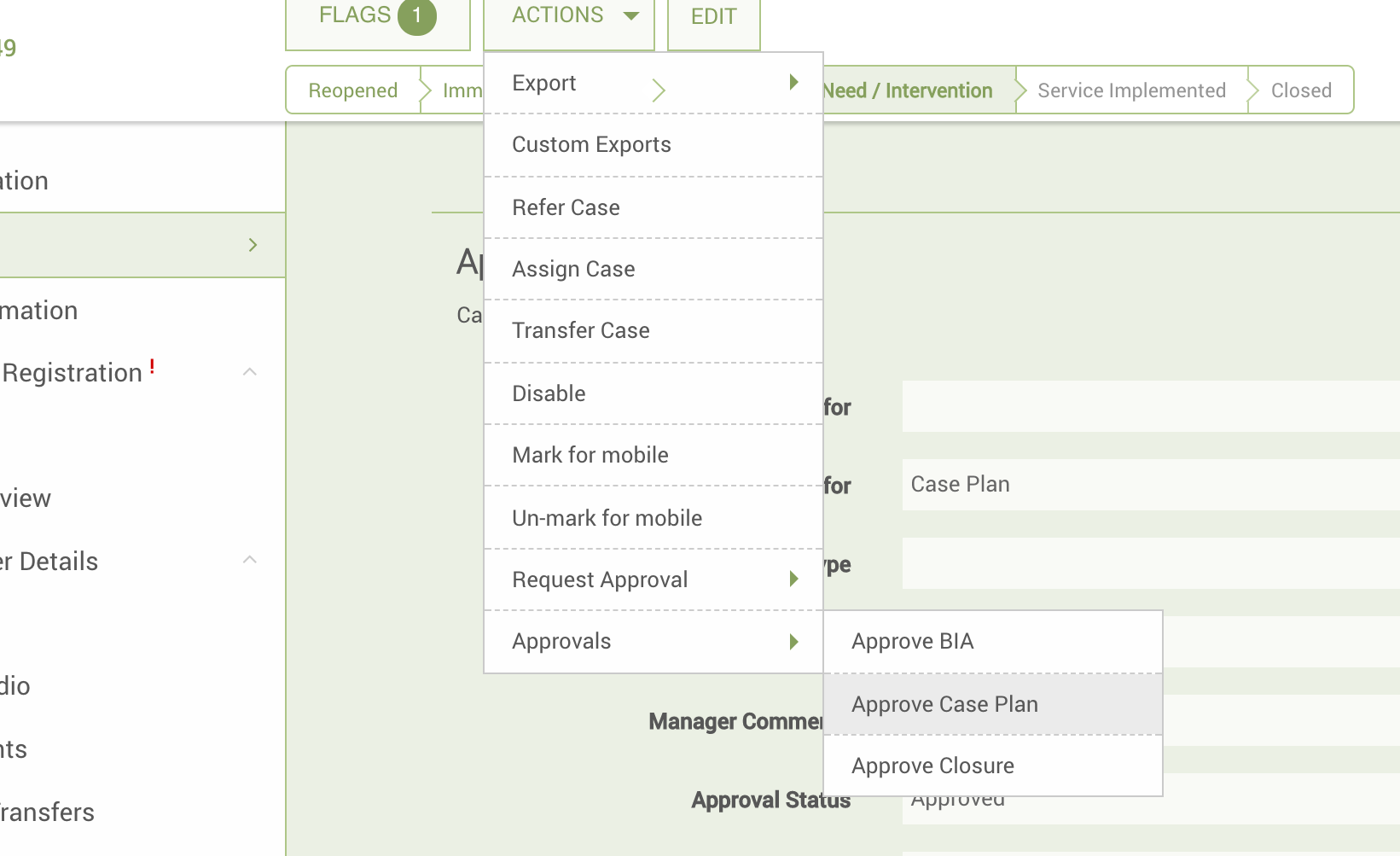

Create Incident from Case
When viewing a GBV case, a case worker can create an incident directly from the case by clicking the "CREATE INCIDENT" button, located next to the ACTIONS button in the Anchored Header. Doing so will re-direct the user to the create incident form, with case information automatically loaded into the Survivor Information form.

Alternatively, a user--depending on configuration--can create an incident from any case from the case list or search results views. To learn more about this capability, read the section labeled "Adding Incident to Case from List View".
Search and Advanced Search
Quick Search
Quick Search refers to the search field in the header navigation bar.
From here you can type in your search and return a list of possible
matches. If you are searching from the cases page you can enter your
case’s value for one of the following fields to find a match: “Long ID,”
“Case ID,” “proGres ID,” “Name,” “Nickname,” “Other Name,” “Ration Card Number,” “ICRC
Ref No.,” “RC ID No.,” “UNHCR ID,” “UN Number,” and “Other Agency ID.”
When looking for a tracing request, you can search these fields: “Long
ID,” “Inquirer ID,” “Name of inquirer,” and “Nickname of inquirer.”
After searching, you can filter results further.
Searching for Records Owned By Others
Depending on your configuration, some users may have the ability to search for records owned by other users. In this case, the records are only be visible in the list view. Clicking on a record in this view does not take the user to the view page for that record. Instead, the user can perform actions on the record from the list review.

To do this, go to the record list page, and search for your record using an id or other searchable field. Once your search results appear, select the check box for the record on which you wish to perform an action. Now, select the action you wish to perform in the action button dropdown.
Adding Incident to Case from List View
Depending on configuration, a user may be able to add an incident to a case from the list view or when searching cases. To add an incident to a case, select your case's check box on the search results page, then, under the action button dropdown, select "Add Incident." You will see the following modal. Here, enter information on the incident you are adding, and then save.

Exporting Information on Records
Exporting individual cases or a list of cases can be useful in a number
of ways. This action can be found in the ACTIONS header button which
will display a drop down to select what format you want to export - PDF,
XLS, CSV, etc.
| Format | Description | Fields Included |
|---|---|---|
| CSV | Stands for “Comma-Separated Values.” Readable in excel, and can be imported back into any Primero instance. | All fields to which the user’s role has access. |
| Excel | Exports to a standard .xls file, which can be re-imported back into Primero. | All fields to which the user’s role has access. |
| JSON | Easiest format to be read (only) by Primero, and the preferred format for importing. | All fields to which the user’s role has access. |
| Photo Wall | Exports a PDF file with the photo of each selected case along with the case’s ID. Cannot be re-imported into Primero. | Photo, ID. |
| PDF file containing a profile on each case, including the fields from the forms specified by the user. Cannot be imported. | All fields specified by the user, to which the user’s role has access. | |
| UNHCR | CSV file specifically formatted to be compatible with UNHCR’s data import. | All fields to which the user’s role has access. |
| Custom | Excel file containing all the fields specified by the user. Can be imported back into Primero. | All fields specified by the user, to which the user’s role has access. |
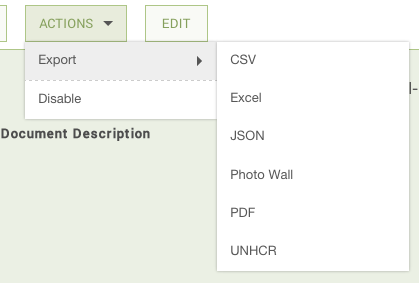
Once you’ve selected your format, the export window will appear, allowing you to set your own password for the file, and create your own file name.

To export a list of cases, while in the case list view, you can select
as many as you’d like to export via the check boxes:

To export all cases, you can leave all unchecked and it will export all
cases you have access to. The bulk export will generate in the background.
You can continue to use the app while it is generating. To access it,
click on the tab with the download icon.

To export a single case, you can either check only that case in the case
list, or enter into the case to view it, then use the ACTIONS button to
export.
Navigating Primero Forms
Once you are creating or editing a record, you will see a navigation list
in the left panel. This list is an organized way to navigate through
your forms. The initial titles you see are called Form Groups and
are set up by your site administrator. The current form you are on will
be highlighted - see below:

If a Form Group has only one form, you can simply click on it and it
will populate the form. If it has more than one, you can click on the
Form Group name or the expand icon to the right of the name to expand it
and see all the forms in the group. Once expanded you can then click on
any of the form names to enter into the chosen form. For example, in the
image above, the user has selected the “Identification / Registration”
form group and the “Case Information” form.
Navigating Sub-Forms
In certain data sets and forms, we find that information pertaining to
an event or entity is nearly identical. For example, information on
specific family members can be the same form, just labeled per family
member name and relationship. So in cases like this, we’ve designed
these forms as “sub-forms,” and you manually add additional individual
forms to add information on family members, individual follow ups, etc.
To navigate those, there is an expand/collapse function, and an
add/remove function.
Alerts
When an incident has been added to your case, you will see a small alert badge next to the incident subform. This helps users keep track of updates to a given case's situation and immediately undertake any necessary responses.

Creating, Updating, or Editing a Case
Creating a Case
To create a case from the case list view, click on the "NEW CASE" button. You will see a modal like the one pictured below. Here, you have two options. The first option is to simply create a case by clicking the "CREATE CASE" button. However, you can also check to see if a case already exists for a child by running a search. (For a list of fields that are searchable, read the "Quick Search" section.) To run a search, simply type your search query into the search box and click the "SEARCH" button. This will take you to a search results page. If no search results appear, you can just create a case by clicking on the "NEW CASE" button again on the search screen.
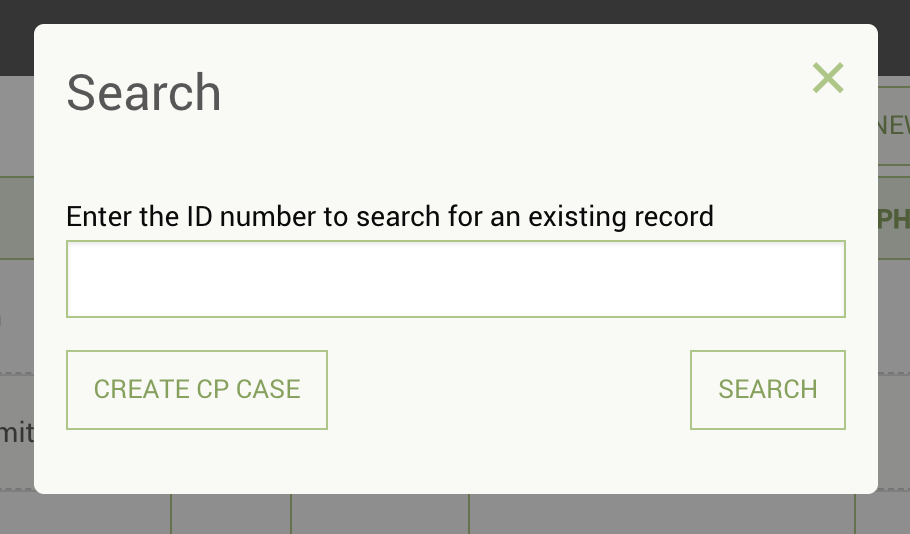
Once you have reached the new case page, you can navigate to different forms as we describe in the “Navigating Primero Forms” section.
Editing a Case
To edit a case, simply located it in the case list view and then click on
it. Once you’ve entered into the case you would like to update, you must
click the EDIT button in the actions header. The page will then
refresh and allow you edit individual form fields.
There are a number of different field types in which you can edit
differently.
Text - Type normally using your keypad or keyboard.
Text Area - Similar to the Text field. Type normally, the field expands for more information as you continue to enter information.
Date - Multiple ways to edit
You can type in a numerical date in the format of dd-mm-yyyy
You can type in the first three letters of the month in the format of 01-Jan-2014
You can use the calendar widget to go to the correct day and select it directly
Check Boxes - You may click one or many of the options using the mouse.
Tick Box - You may click on the box using the mouse.
Select Drop Down - Click any option to select it.Multi-Select Drop Down - Begin typing and either hit ‘enter’ or click to select multiple options.
Radio Button - Similar to Tick Box, click on the correct answer using the mouse
Numeric Field - Key the number into the field.
Tally Field - Key in the number you need for each tally. The total automatically calculates based on the tally fields and is not editable in itself.
When you attempt to save, there is always the possibility that one or
more of the fields you entered will be formatted incorrectly. For
instance, if you try to fill in the “Date of Birth” field--which is
supposed to be a format-specific date--with the words, “a pretty long
time ago,” Primero will be unable to save the information. In that case,
after you hit the “save” button, the case will fail to update with your
new information, and the “Date of Birth” field’s label will be
highlighted in red, to inform you that the field has been entered
incorrectly.
Generating Automatic Follow Ups
While you are making changes to a case, you can make your job managing
the case easier by having Primero generate reminders to perform a follow
up every two weeks. To do this, click on the “Protection Concerns” Form
Section, under the “Identification / Registration” Form Group and check
the “Generate follow up reminders?” tick box. If you click save, Primero
will automatically create a flag (to be discussed later) on the case for
you, once every two weeks, which will remind you to perform a follow up.
This feature may or may not be turned on.
Transfers and Referrals
Transfers
Transferring a record is a basic form of reassignment. There are some
processes surrounding this for a transfer to a non-Primero individual or
a Primero user outside your instance. But those will be determined by
your organization and the sharing protocol of the organization of the
person you are transferring to.
To transfer a record from either the individual record page or the list
view, use the ACTIONS button in the Action Header to initiate the drop
down of options. Within the options, select “Transfer Case.”

The following modal form will appear and allow you to select options for
your transfer. Consent of the individual (or a consent override) is
generally needed for transfers, although not for those which take place
within the same Primero instance.
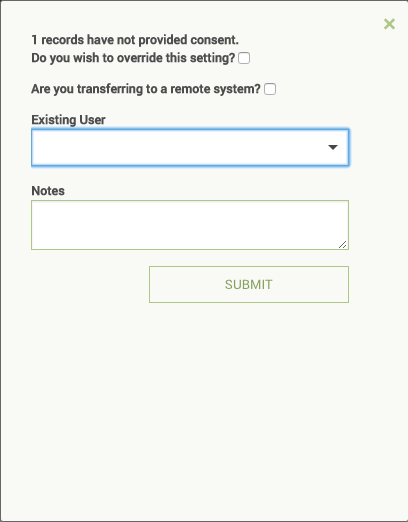
If you are transferring within your Primero instance, select the
“Existing User”--a user within your deployment of Primero. If the
desired user is not in the drop down, it means this user does not have
privileges to be transferred to.
If you are not transferring within the Primero instance, check the “Are
you transferring to a remote system?” tickbox, and more options will
appear for this “remote” transfer. A remote transfer creates a transfer
export that is password protected to be shared outside the system.

If you are transferring to a user outside your system who is using
another Primero instance, you simply select “Primero” in the drop down
marked “What type of export do you want.” In this case, the file Primero
exports will be a JSON file which can be imported into the remote
Primero system.
Note:
When transferring any such password-protected export/import file, the
means of sending the file, filename, and the password that opens it,
will be determined by the Information Sharing Protocol (ISP) decided
by the appropriate local steering committee. When determining this
policy, on-the-ground security considerations will be at play, as well
as the ease and speed of physical transport within the country.
Accepting or Rejecting Transfers
Based on the deployment, you may have the ability to accept or reject a case that has been transferred to you. You will be able to see if any cases have been transferred to on your dashboard. If you click on the Referrals and Transfers form for the case that has been transferred to you, you will see that the status is in progress and that there are buttons to either accept or reject the transfer. If you click to accept the case, the status will change to accepted, and you will become the record owner, rather than an “other assigned user”. The record information is updated with this change. If you click Reject, it brings up a dialog box with an OK button and a textbox to enter the Rejection Reason. When you click OK, the rejection reason is saved to the nested subform. The status is changed to 'rejected, and you are removed from 'other assigned users' and no longer have access to the record.

Referrals
Referring a record is a way of giving a user limited access to a record
without transferring it completely. As with transfers, there are some
processes surrounding this action when referring to a non-Primero
individual or a user outside your instance. These processes, however,
will be determined by your organization and the sharing protocol of the
organization of the person you are referring to.
To refer a record from either the individual record page or the list
view, use the ACTIONS button in the Action Header to initiate the drop
down of options. Within the options, select “Refer Case.”

The following modal form will appear and allow you to select options for
your referral. As with transfers, consent (or a consent override) of the
individual is generally required for a referral.
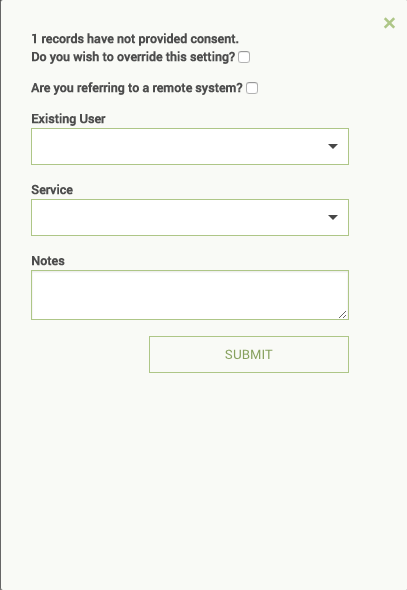
If you are making a referral within your Primero instance, select the
“Existing User”--a user within your deployment of Primero. If the
desired user is not in the drop down, it means this user does not have
privileges to be referred to. You must also select the type of service
that will be rendered by the user to whom you are referring.
If you are not making a referral within the Primero instance, check the
“Are you referring to a remote system?” tickbox, and more options will
appear for this “remote” referral. A remote referral creates a referral
export that is password protected to be shared outside the system.
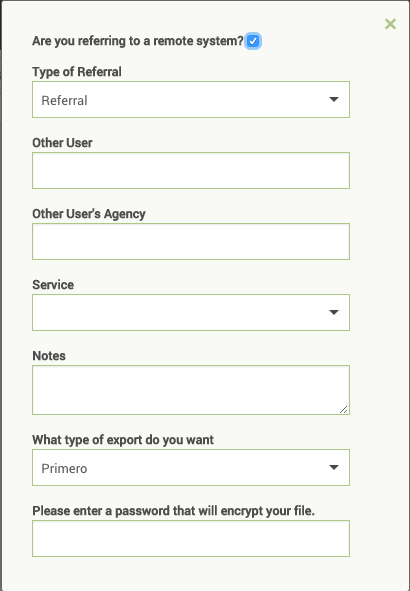
If you are making a referral to a user outside your system who is using
another Primero instance, you simply select “Primero” in the drop down
marked “What type of export do you want.” In this case, the file Primero
exports will be a JSON file which can be imported into the remote
Primero system.
To specify which service a referral is for, go to the services form and click on the "refer" button on the header for any service you have saved.

Once you have clicked "refer" you will see the below modal. Once again, make sure you have consent (or a consent override), and select a user who will receive the referral. The service type should already be selected for you, based on what you entered in the Services form.

Relinquishing Referral
Based on the deployment, you may have the ability to relinquish a case that has been referred to you. You can see if any cases have been referred to you on your dashboard. When you click on the Referrals and Transfers form for the case that has been referred to you, you will see a DONE button next to the referral that has been made to you. If you are done reviewing the case, you can click the done button. Once clicked, it will be removed from your case list and you will no longer have access to it.

Reports
Reports allow users to see a high-level, aggregate view of data, helping
them to understand trends and coming challenges in their work. Only
certain roles--and thus certain users--will have the ability to create
or view reports. Some users will be able to navigate to the Reports
section of the application and view existing reports but not edit them
or create new ones, while others will have the ability to view, create,
edit, and export reports.
Creating a Report
To create a report, first click the Reports icon in the top toolbar.
You will see that there are already a number of pre-built reports which
you can view at any time. To start your own, click the Create Report
button at the top of the screen.

When you have reached the new report form, be sure to enter a name and
description for your report. You must then specify the module from which
to draw the records for your report, as well as the type of records you
want to be drawing upon. Here, we have chosen the Child Protection
module, and the Case record type.

Next comes choosing the row and column attributes by which you want your
data to be grouped. The first item you choose in each field will be the
outer grouping layer, with each successive item acting as a
sub-categorization. Taking a look at the example below, we can see that
the columns of our report have been first divided by sex, and then
sub-divided by permanent district/chiefdom, since these are the first
and second “Group by column” attributes, respectively. We can see that
the rows of the report follow the same pattern.


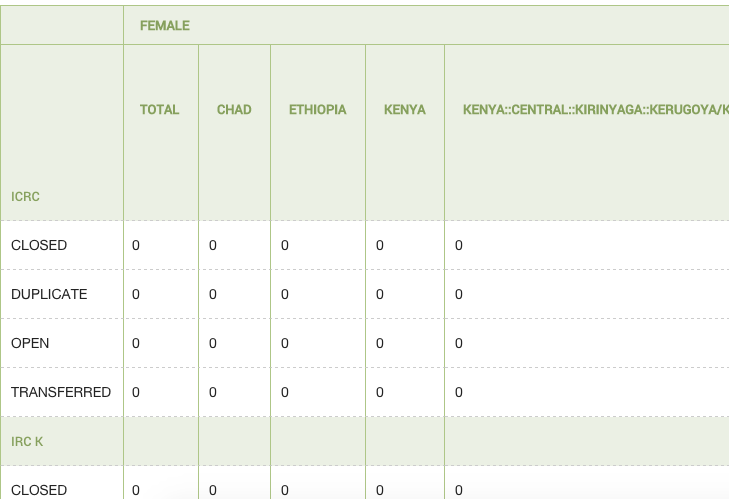
The columns of your report will be augmented by a final “Total” column,
which shows the aggregate for each row. It is important to note that the
numbers in each of your columns may not add up to the number in your
total column, since many attributes will go undefined by the workers
doing registration. For instance, in the example below, three cases with
the “child has been abandoned” protection concern were never assigned a
sex, resulting in a report with one female, no males, and four total
cases.

Furthermore, any reports based on fields within certain nested forms
will automatically count a field for each saved record, even if a nested
form for this field was never filled out. This is because Primero
automatically populates an empty subform on the page for form sections
such as “Protection Concerns,” so that the user can easily enter
information. When a user fails to enter information for that field,
however, the field still counts as a single item. For instance, if you
were to create a case and fail to enter any information into the blank
Protection Concerns subform, a report outlining how many cases had each
type of protection concern would still count your case as having a
single protection concern type, even though you had never entered any
information on the Protection Concerns subform. This would then count
into the total, without counting into the column for any single one of
the protection concern types. Taking a look at the example below, we can
see that, in the Freetown district, one child has been registered as
abandoned and one with a protection concern type of “Extreme levels of
poverty.” But the total number of protection concerns for this district
is three, meaning that one case was registered with a protection concern
form where the protection concern type was never filled in.

After you have defined the row and column attributes for your report,
you will choose the fields from which you will receive an aggregate
count. This feature obviously only works on numeric fields. To give an
example of how it works, imagine we have a report that disaggregates
your cases based on number of children in the family and date of birth
(by year). Three cases end up going into the report: one born in 2004
whose family has three children, one born in 2001 whose family has six
children, and another born in 2001 whose family also has six children.
Here is what the report would normally look like:

As you can see, the 2001 column has the number “2” in the “7” row, since
there are two cases born in 2001 whose families have seven children. We
see this same number in the “Total” column for the “7” row for the same
reasons. If we choose to have aggregate counts on the “Number of
children” field, however, the report would look like this:

Now, instead of seeing that there are two cases that meet the criteria
for being born in 2001 and having a family with seven children, we
instead see the number “14,” representative of fourteen total children.
Once again, this field also shows up in the “Total” column.
Age Range
The next field, specifying age range, helps make reports involving age
more manageable by grouping them into a smaller list of ranges. The two
images below exemplify the usefulness of this feature. The first shows
part of a sprawling report without age ranges enabled. The second shows
the same report with age ranges.
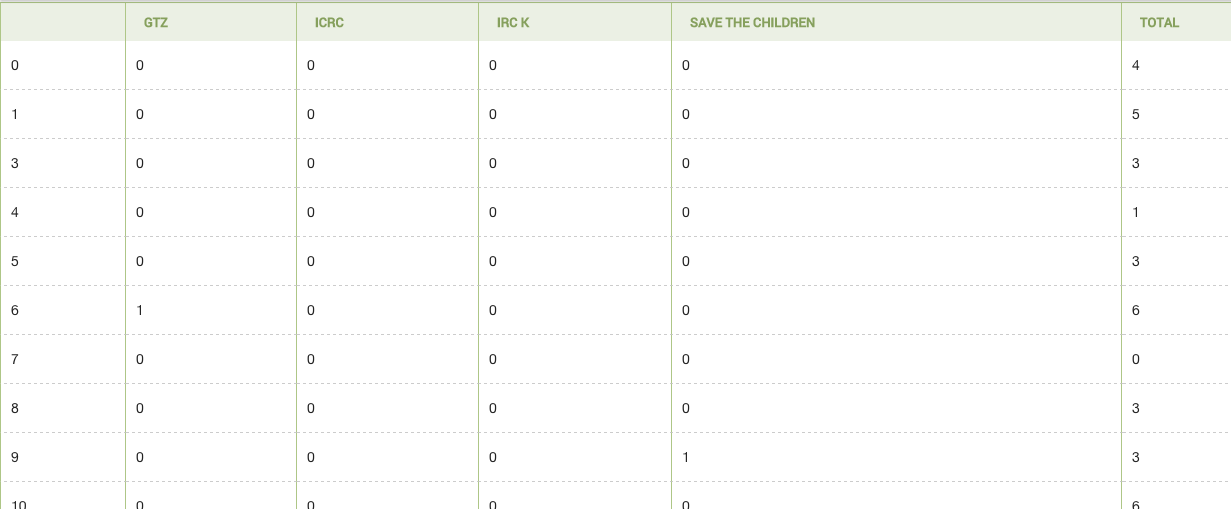


Date Ranges
The next field, “Use date ranges,” allows you to do much the same thing,
but with date fields instead of ages. Now, instead of having to have a
column for every date over a two year period--as would be the case with
the default, day-long range--you can disaggregate your records by
whether or not they fit into week-, month-, or year-long spans of time.
Filters
Next, you can put filters on the records you are using to eliminate
irrelevant data. By default, each report filters to include only those
records with a “Case Status” of “Open” and a “Valid Record?” value of
“Yes.” You can create a filter on any single-select, multi-select, tick
box, check box, radio button, number, tally, or date field, and for each
one, you can specify which values are acceptable for records being
included into the report.
Finally, you are asked whether you would like to generate an exportable
graph of your report.
Viewing your reports
If you click save on your report, and it saves successfully, you should
arrive at the view page for your report. You will first see a table
representing your report. Above the table, you should see either one or
two tabs. The first, marked “Table,” represents what you currently see.
The second, which will only appear if you specified that your report
should generate a graph, will be marked “Graph” and will show you just
that.

You can also use the Export button above the tabs to export either
the data (in CSV form) or the graph (as a .png image file). Below is an
example of a graph generated and then exported from a report.
